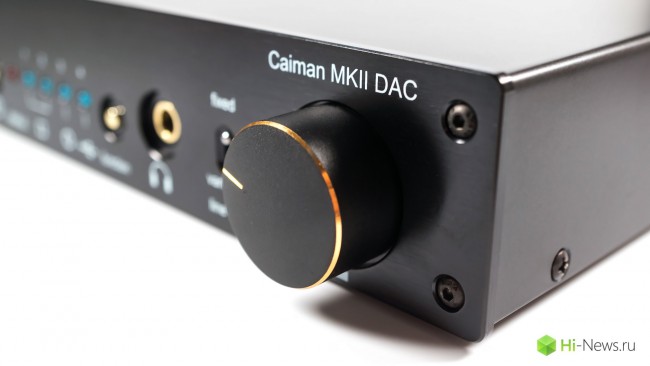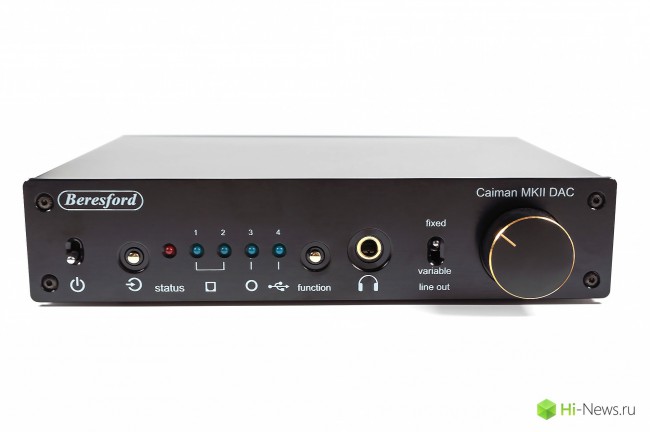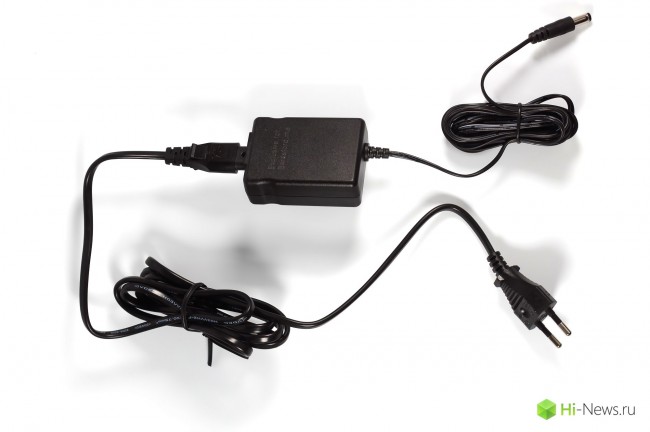
DAC, which will be discussed today, got my hands on back in October of last year and permanently settled at my Desk. Into force of trips, holidays, to write about it all did not reach hands. Finally I decided it was a misunderstanding to be corrected. So, the first of two reviews about the technique Beresford, Caiman MKII DAC review.
This digital-to-analog Converter designed by British audio engineer Stanley Beresford and contains many original ideas, which is rarely used in other products. The main feature of this model is to use a special processor with proprietary algorithms to normalize the input signals. Asynchronous USB in our time is no surprise, but the Caiman and buffers data received over SPDIF, 1024 byte buffer allows you to not worry even when working with very high-quality digital audio. Found in the design space for taktaeva good generator of the receiver of the digital signal, and thorough filtering power, good headphone amplifier operating in class A-B.
The DAC tried as little as possible interfere with the signal at its analog stage. The linear output is made without dividing capacitors, which allows the DAC to reproduce the frequency to 1 Hz (fans of the movies and subs will appreciate it). Low-pass filter signal is made to Deposit a minimum of distortion in the treble range.
An interesting feature of the devices — support resolutions up to 32 bit and 768 kHz. To feed this DAC from the bundled power supply and 12-volt battery (but I didn’t bother).

Despite a lot of interesting possibilities, the price of Caiman is very affordable, the developers ask for it only 166 pounds plus the money for shipping that, in General, very little on the background of other solutions.
Design and management
Box the device is quite simple: brown cardboard without any frills. Inside you will find the DAC itself, power supply and instructions. All neatly Packed in cellophane and secured foamed polymer.
The DAC itself has been just great. The case is full metal, black. There are options with silver and black front bezels. The device is assembled very carefully for its price and looks much more expensive than the actual cost.

By tradition, all the controls are concentrated on the front and rear panels. Ahead are: power toggle, led indicator, 4 led indicating the input source button select the source, multifunction control button, a switch that allows you to disable volume control line out, earphone socket and volume control.
Rear panel houses connectors: 2 RCA jacks line output, proprietary connector, I2C connector, USB input, S/PDIF coaxial, two optical S/PDIF terminal for optional ground power connector (from 11 to 15 volts of DC voltage). The ground terminal is a good idea, such solution is quite rare, but if you are faced with the problem of earth loops when connected to the amplifier, this option will help you. Included with the DAC is a good PSU, but can use a 12-volt battery, what they do for recharging laptops. Also, if you use the DAC with amplifier Capella, you can use one PSU for two.
A few observations about the usability of the device.

Volume control — smooth and achumawi, audible offset channel no. Golden ring on the control knob well dilutes the monotone black color of the front panel. With the switch you can choose, does this control line output or only naushnikov. If you connect a device to the headphone amplifier or preamplifier to your system, the adjustment of linear output can be disabled if you want to connect immediately to the “assistant” without “pre”, adjustable line out is very useful.
Many digital inputs does the Caiman convenient center of your digital ecosystem, integrating various sources of digital audio. The device can work in two modes — automatic and manual. In the first he is looking for which inputs to include, in the second you select the modes using the selection buttons.
I do not quite clearly understand the difference of the regimes “clean” digital signal (as I wrote above, there’s already 4), but, to my ears, sounds best No. 3, although when connected via USB, the difference is somewhere on the border of perception.
If you are annoyed with the LEDs, the DAC is a mode in which it disables them when it finds a signal source, turn it on by Fn button.
Generally, of course, one of the management buttons to these devices is not enough. Because of this, it “hung” a lot of functions that is a bit misleading management. However, given the fact that these settings don’t change every 5 minutes, and Caiman remembers them, it is enough to configure all of 1 time and then can use it.

In General, despite some old-fashioned, this DAC looks much more expensive than it should, and it always pleases.
The sound
For the listening device was used the following equipment:
- MacBook Pro Retina Late 2013 as a source
- Audirvana Plus in the role of player
- Omni ZMF headphones, Oppo PM-3, Titan 1 Dunu, Dunu DN-2000J, Lear LHF-AE1d and other
- Beresford Capella and NuPrime DAC-10H in the role of amplifiers
- Record in lossless format
I don’t know exactly what chips are used in this DAC, judging by the scraps of data from the Internet — something not very top from Wolfson, but abstracting from particular chips, the sound of the Beresford is clearly a success. To evaluate Caiman have twice: as a pure DAC with a linear output, and how the combine with the headphone output. Their sound is quite different.
To begin with — a pure DAC. Very good, close to neutral sound, with deep bass (if your system is able to act) and free of tension RF in the supply there is a small hint of pritenennoe, but it causes no effect of turbidity and lethargy.

Bass speed is not prohibitive, but sufficient for most parties, a study of lecturesthe very nice, there is a good separation of the layers. Especially nice is the presence of very deep bass, although it is perhaps valuable only for owners of subwoofers, as naushnikov tracts may not adequately offset intrafactory.
Mid — life, there is a small smoothing, giving the flow of musicality, but it’s not hides the emotions and nuances. Study of the vocal is good for this price, the device is equally able male and female party. Scene is deep enough, the width is somewhere between medium and wide. Tools efficiently separated, their character is transmitted reliably.
Vernacularly range turned out to be “free of tension”. Treble slightly reserved on the second plan and execute a “subsidiary” role in the supply device. Because of this the Caiman sound a bit lacking in airiness, but not critical. In combination with a bright amplifier/headphones, this DAC still may cut the ear HF vobu.
The headphone output has a very different from linear flow. Then go deep and the bass emphasis in the sound shifting towards midrange and low treble. Overall naushnikov amplifier here budget made though to hear it can be quite a pleasure.
The bass is not as deep as in the line out, there is a small problem with speed, but not critical, in General, within the budget it can be considered good.
MIDs headphones slightly highlighted, it adds to the sound sense of “intimacy” that is good for some genres like jazz and vocal music, but brutal styles from this lose. Scene is medium in width and depth, separation of instruments is good, too.
The RF headphone are represented in slightly greater numbers than on the linear output, but also do not have a record resolution. In fairness, it should be noted that this is a common problem of low amps.

In General, I would consider the Caiman as a DAC, the headphone output is a nice additional option. Roughly speaking, as the DAC this device plays more than its price, but as the harvester is just about on par with the competition on price niche.
Compatibility
If you listen Caiman MK II headphone amplifier, I would have picked him headphones with a V-shaped flow, with good will, for example, Buyers DT series (from 770 to 990) and similar “taste” decisions. For IEM to use this processor, of course, possible, though not optimally. When connecting the speakers, the situation changes significantly, since the main contribution to the flow is transferred to the amplifier, and there already all depends largely from it. By the way, from Beresford Capella amp is also very interesting, he will be devoted to one of the following reviews.
Genre and special preferences of the DAC no, but you should understand that the device belongs to the initial segment (although plays more of its value), so expect special miracles is not worth it.
Traditionally tracks the examples.
Rush — Distant Early Warning. Listening to Rush, I always wondered how three musicians can many years to create interesting and diverse music. The answer to this question is still no, but this does not prevent me to enjoy their creativity. A good solution midrange Caiman allows him to fully convey all the nuances of such tracks.
Bjork — Lionsong. On this track the Caiman shows itself in all its glory: deep bass contrasted with emotional vocals and string section, generating an amazing meditative soundscapes, which are so well suited to supply this device.
Steven Wilson 3 Years Older. The music is absolutely impossible to hear the background to something. Any attempt to listen to this album Wilson doing something along the way that will lead to the fact that he “slip” of the brain, is absolutely not saponinas. Meanwhile, this is a very complicated and multifaceted job, full of unexpected moves, just for its perception requires maximum concentration. Plus a good equipment, in the role of a budget option which was doing well Caiman.
Conclusions
Very interesting device with great potential for anyone looking for a good desktop DAC, which combines a stylish look, good sound and affordable price. I especially liked the bond between the device and the amplifier Capella, but without power and combine more than justifies its cost.
